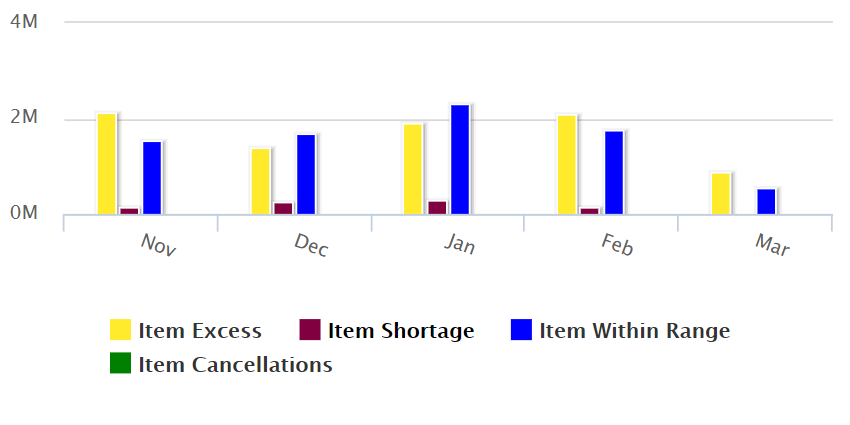Customer as Teacher
Our customers are great teachers who have always helped us bridge the gap between textbook theory and practical application of forecasting and demand planning. Our latest bit of schooling concerns “blanket orders” and how to account for them as part of the demand planning process.
Expanding the Inventory Theory Textbook
Textbook inventory theory focuses on the three most used replenishment policies: (1) Periodic review order-up-to policy, designated (T, S) in the books (2) Continuous review policy with fixed order quantity, designated (R, Q) and (3) Continuous review order-up-to policy, designated (s, S) but usually called “Min/Max.” Our customers have pointed out that their actual ordering process often includes frequent use of “blanket orders.” This blog focuses on how to incorporate blanket orders into the demand planning process and details how to adjust stocking targets accordingly.
Demand Planning with Blanket Orders is Different
Blanket orders are contracts with suppliers for fixed replenishment quantities arriving at fixed intervals. For example, you might agree with your supplier to receive 20 units every 7 days via a blanket order rather than 60 to 90 units every 28 days under the Periodic Review policy. Blanket orders contrast even more with the Continuous Review policies, under which both order schedules and order quantities are random. In general, it is efficient to build flexibility into the restocking process so that you order only what you need and only order when you need it. By that standard, Min/Max should make the most sense and blanket policies should make the least sense.
The Case for Blanket Policies
However, while efficiency is important, it is never the only consideration. One of our customers, let’s call them Company X, explained the appeal of blanket policies in their circumstances. Company X makes high-performance parts for motorcycles and ATV’s. They turn raw steel into cool things. But they must deal with the steel. Steel is expensive. Steel is bulky and heavy. Steel is not something conjured overnight on a special-order basis. The inventory manager at Company X does not want to place large but random-sized orders at random times. He does not want to baby-sit a mountain of steel. His suppliers do not want to receive orders for random quantities at random times. And Company X prefers to spread out its payments. The result: Blanket orders.
The Fatal Flaw in Blanket Policies
For Company X, blanket orders are intended to even out replenishment buys and avoid unwieldy buildups of piles of steel before they are ready for use. But the logic behind continuous review inventory policies still applies. Surges in demand, otherwise welcome, will occur and can create stockouts. Likewise, pauses in demand can create excess demand. As time goes on, it becomes clear that a blanket policy has a fatal flaw: only if the blanket orders exactly match the average demand can they avoid runaway inventory in either direction, up or down. In practice, it will be impossible to exactly match average demand. Furthermore, average demand is a moving target and can drift up or down.
How to Incorporate Blanket Orders when Demand Planning
A blanket policy does have advantages, but rigidity is its Achilles heel. Demand planners will often improvise by adjusting future orders to handle changes in demand but this doesn’t scale across thousands of items. To make the inventory replenishment policy robust against randomness in demand, we suggest a hybrid policy that begins with blanket orders but retains flexibility to automatically (not manually) order additional supply on an as-need basis. Supplementing the blanket policy with a Min/Max backup provides for adjustments without manual intervention. This combination will capture some of the advantages of blanket orders while protecting customer service and avoiding runaway inventory.
Designing a demand planning process that accounts for blanket orders properly requires choice of four control parameters. Two parameters are the fixed size and fixed timing of the blanket policy. Two more are the values of Min and Max. This leaves the inventory manager facing a four-dimensional optimization problem. Advanced inventory optimization software will make it possible to evaluate choices for the values of the four parameters and to support negotiations with suppliers when crafting blanket orders.


 What about the thousands of other items that have a Min/Max, safety Stock, Reorder Point, or other parameters that isn’t being reassessed given the updated demand and supply data. The planner isn’t reviewing any of these items which means problems aren’t being identified in advance. Compounding the problem is that when Peter does make a change he doesn’t have any tools to assess the quality of his changes. If he modifies the min/max settings he doesn’t know the specific impact this will have on inventory value, ordering costs, holding costs, stock outs, and service levels. He only knows that an increase in inventory will likely improve service and increase costs. He doesn’t know for example whether his inventory has reached a point of
What about the thousands of other items that have a Min/Max, safety Stock, Reorder Point, or other parameters that isn’t being reassessed given the updated demand and supply data. The planner isn’t reviewing any of these items which means problems aren’t being identified in advance. Compounding the problem is that when Peter does make a change he doesn’t have any tools to assess the quality of his changes. If he modifies the min/max settings he doesn’t know the specific impact this will have on inventory value, ordering costs, holding costs, stock outs, and service levels. He only knows that an increase in inventory will likely improve service and increase costs. He doesn’t know for example whether his inventory has reached a point of 










